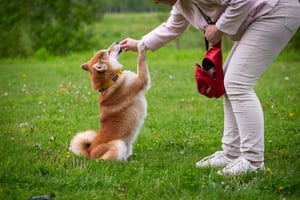Training a puppy not to bite is essential for their safety, as well as for the safety of those...
How to Teach a Puppy Not to Bite
Training a puppy not to bite is essential for their safety and the safety of those around them. It is also important for the puppy's development and wellbeing. In this article, we will discuss the best ways to teach a puppy to stop biting and how to use positive reinforcement techniques to create long-lasting results.
Why Do Puppies Bite?
Puppies bite for a variety of reasons. They might be teething, exploring their environment, or seeking attention. It is important to understand why your puppy is biting in order to develop an effective training plan.
Biting is a natural behavior for puppies and it can be difficult to break. However, it is important to do so as it can cause injury. Puppies can also become aggressive if their biting is not addressed.
Tips to Stop Puppy Biting
The following tips can help you teach your puppy not to bite:
- Be consistent: Establish a set of rules and stick to them. This will help your puppy understand what is expected of them.
- Redirect: When your puppy starts to bite, redirect them to an appropriate toy or activity. This will help them learn that biting is not allowed.
- Reward good behavior: Give your puppy praise and treats when they behave appropriately. This will help them learn that good behavior is rewarded.
- Discourage bad behavior: When your puppy bites, use a firm "no" and remove yourself from the situation. This will help them understand that biting is not acceptable.
- Be patient: Training a puppy not to bite takes time and patience. Don't get discouraged and keep working with your puppy until they understand.
Positive Reinforcement Training
Positive reinforcement training is an effective way to teach a puppy not to bite. This type of training relies on rewards and praise to reinforce good behavior, rather than punishment for bad behavior.
When using positive reinforcement, it is important to reward your puppy for good behavior and ignore bad behavior. For example, if your puppy is biting, ignore them and offer them a toy instead. When they start playing with the toy, reward them with praise and a treat.
Positive reinforcement training can be used to teach a variety of behaviors, including not biting. This type of training is effective because it encourages good behavior and discourages bad behavior without using punishment.
Conclusion
Teaching a puppy not to bite is essential for their safety and the safety of those around them. It is important to understand why your puppy is biting and use positive reinforcement training to create long-lasting results. With patience and consistency, you can teach your puppy not to bite and create a positive and safe environment for everyone.



